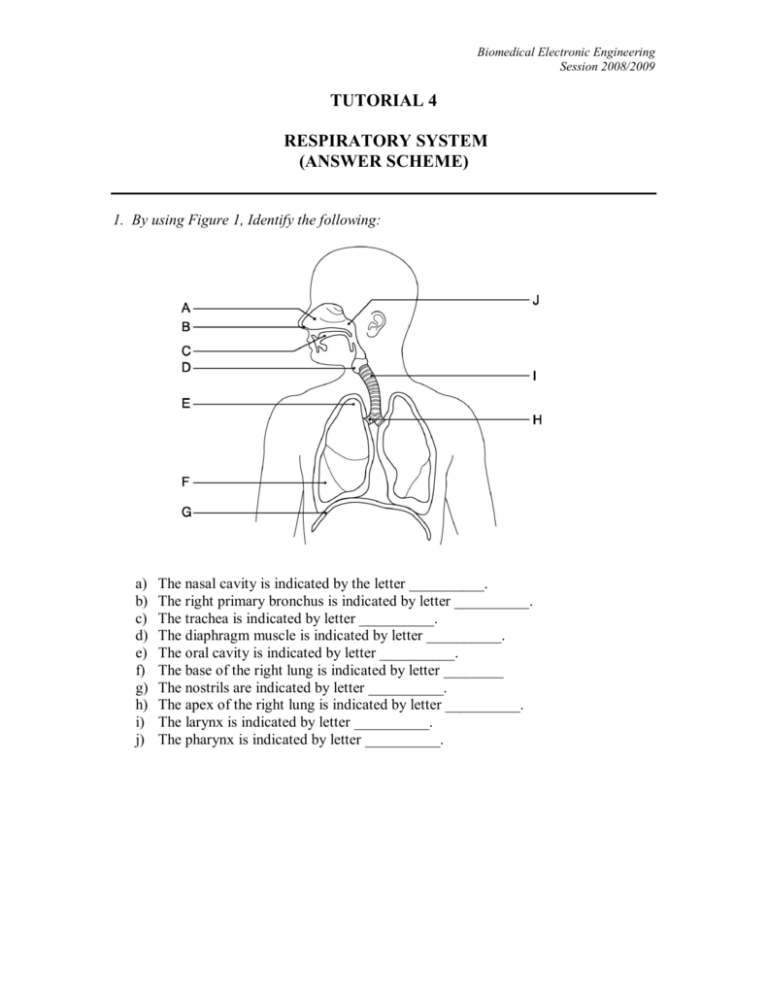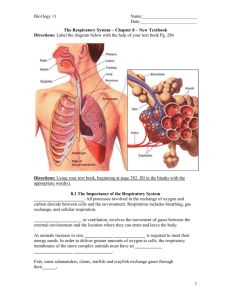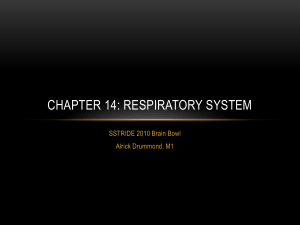Answer scheme Tutorial 4
advertisement

Biomedical Electronic Engineering Session 2008/2009 TUTORIAL 4 RESPIRATORY SYSTEM (ANSWER SCHEME) 1. By using Figure 1, Identify the following: a) b) c) d) e) f) g) h) i) j) The nasal cavity is indicated by the letter __________. The right primary bronchus is indicated by letter __________. The trachea is indicated by letter __________. The diaphragm muscle is indicated by letter __________. The oral cavity is indicated by letter __________. The base of the right lung is indicated by letter ________ The nostrils are indicated by letter __________. The apex of the right lung is indicated by letter __________. The larynx is indicated by letter __________. The pharynx is indicated by letter __________. Biomedical Electronic Engineering Session 2008/2009 2. Fill in the blank or provide a short answer: a) i. ii. iii. iv. v. The three mucosa-covered projections into the nasal cavity that greatly increase surface area of mucosa exposed to air are called __conchae__. The anterior portion of the palate that is supported by bone is called the _hard palate_. The throat is also known as the _ pharynx__. Inflammation of the sinuses that can cause marked changes in voice quality is called _sinusitis_. The mucosa-lined windpipe that extends from the larynx to the level of the fifth thoracic vertebra is called the __trachea_. b) i. ii. iii. iv. v. The opening between the vocal folds is called the _epiglotis_. The C-shaped rings that reinforce the trachea are constructed of _hyaline___ cartilage. The smallest conducting passageways of the lungs are called __bronchioles___. "Dust cells" that wander in and out of the alveoli, picking up bacteria, carbon particles, and other debris, are actually _macrophages_. The air sacs of the lungs are called __alveoli_. c) i. ii. iii. iv. v. Chronically inflamed, hypersensitive bronchial passages that can be irritated by dust mite and cockroach droppings are indicative of _ asthma__. Enlargement of the alveoli and chronic inflammation of the lungs are characteristics of a respiratory disease called __emphysema__. A normal respiratory rate of about 12-15 breaths per minute is called _eupnea_. During internal respiration, the blood gas __carbon dioxide___ is loaded into the bloodstream. Inadequate oxygen delivery to body tissues is called __hypoxia___. Biomedical Electronic Engineering Session 2008/2009 3. TRUE / FALSE questions; a) i. The larynx routes air and food into their proper channel and plays an important role in speech production. ( T ) ii. The "guardian of the airways" that prevents food from entering the superior opening of the larynx is the thyroid cartilage. ( F ) iii. The pharyngeal tonsils are also known as the adenoids. ( T ) iv. The emergency surgical opening of the trachea is called a tracheostomy. ( T ) v. The C-shaped rings of cartilage that reinforce the trachea are made of elastic cartilage. ( F ) b) i. The superior portion of the lung is called the base. ( F ) ii. The bronchioles are the smallest of the conducting passageways in the lungs.( T ) iii. Inflammation of the pleura is often caused by decreased secretion of pleural fluid called pleurisy. ( T ) iv. The respiratory membrane is the air-blood barrier, where gases are exchanged.(T) v. The respiratory zone includes the respiratory bronchioles, alveolar ducts, alveolar sacs, and alveoli. ( T ) c) i. The process of breathing is known as pulmonary ventilation. (T) ii. Inspiration results when the diaphragm and external intercostal muscles relax. (F) iii. Expiration occurs when the thoracic and intrapulmonary volumes decrease and the intrapulmonary pressure increases. (T) iv. The amount of air that can be forcibly inhaled over the tidal volume is about 2100 to 3200 mL. (T) v. The total amount of exchangeable air in a healthy young male is typically around 4800 mL. (T) d) i. According to the laws of diffusion, movement of a respiratory gas occurs toward the area of higher concentration of that particular respiratory gas. ( F ) ii. The general term for inadequate oxygen delivery to body tissues regardless of the cause is called hypoxia. ( T ) iii. Venous blood in systemic circulation is poorer in oxygen and richer in carbon dioxide.(T ) iv. Inspiration by the diaphragm muscle is regulated by the phrenic nerves. ( T ) v. The lungs of the fetus are filled with air late in pregnancy. ( F ) Biomedical Electronic Engineering Session 2008/2009 4. Short Essay Questions a) Explain the roles of mucus and cilia in the respiratory system. (6 marks) Answers; Respiratory mucosa lines the nasal cavity which produces sticky mucus. This mucus moistens the air and traps incoming bacteria and other foreign debris entering the nasal cavity. The ciliated cells of the nasal mucosa move this contaminated mucus posteriorly toward the pharynx where it can be swallowed. The trachea is also lined with ciliated mucosa. These cilia move contaminated mucus toward the throat where it either can be swallowed or spat out. b) List the three regions of the pharynx and identify their relative superior and inferior endpoints in the respiratory passageway. (6 marks) Answers; The three portions of the pharynx are the nasopharynx, the oropharynx, and the laryngopharynx. The nasopharynx is the superior portion that extends from the nasal cavity to the soft palate. The oropharynx is the central portion that lies between the soft palate and the upper epiglottis. The laryngopharynx is the most inferior portion and is the connecting point to the larynx below.









